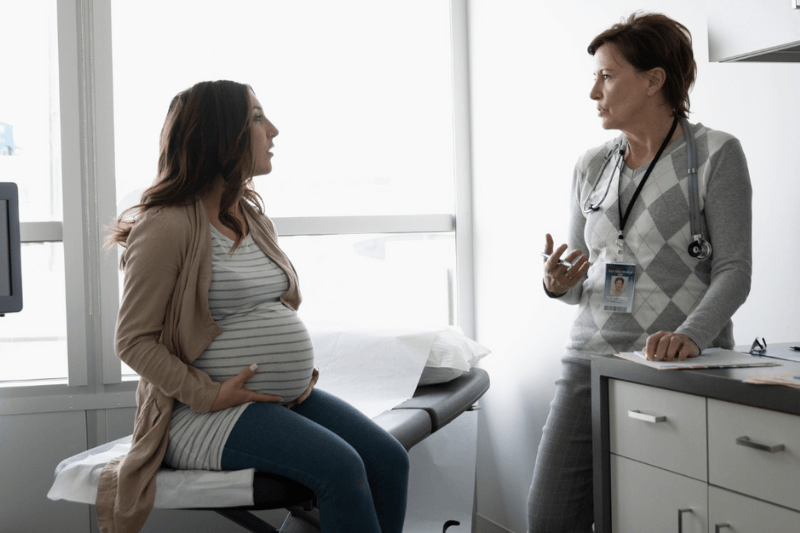The ovaries are the small glands on either side of the uterus that create, store and release eggs as part of the reproductive process. They also produce hormones that control ovulation and the menstrual cycle, so they play a key part in the health and wellbeing of reproductive-aged women.
If you ever feel pain or an aching sensation in the lower abdominal area, this could be ovarian pain. There are a number of possible causes of pain in the ovaries and, while it’s not always a cause for concern, it’s important to know when to see a doctor.
We’ve put together this guide to ovarian pain to help you know what to look out for.
What does ovarian pain feel like?
The nature of ovarian pain will vary depending on the cause. You could feel it in the lower abdomen, just below your belly button, in your pelvis or in your lower back, and it can sometimes radiate down to the groin area. If the pain is associated with ovulation, you may only feel it on one side of the abdomen or pelvis at a time.
Pain in the ovaries can feel like a frequent or constant dull ache, general discomfort or the sensation of pressure in the area, which lasts for a long time. Alternatively you may experience more of an acute, sharp pain that comes in waves.
In many cases, pain or discomfort is related to the menstrual cycle and goes away in a few days. But ovary pain can also be a result of an underlying condition, so you need to know what to look out for and when to speak to a medical expert.
Seven possible causes
There are various underlying medical conditions that can cause pain, discomfort or the sensation of pressure in the ovaries. Some are common and relatively simple to treat while others are more difficult to identify. Here are seven causes to be aware of.
1. Ovulation
Pain during ovulation usually occurs each month, halfway through your menstrual cycle. It’ll typically feel like a dull ache on one side of your pelvis, because only one ovary releases an egg at a time, though the pain can be sharper and more sudden.
Other symptoms could include:
- nausea,
- light bleeding
- or discharge.
Ovulation pain doesn’t usually last more than a few days, though in some cases it can go away in a matter of minutes or hours. You may also experience pain in the area around the ovaries just before or during your period. These menstrual cramps happen when the uterus contracts.
Ovulation pain and menstrual cramps are not usually a cause for concern, although they can be an indicator of a more serious condition like endometriosis or a sexually transmitted infection (STI).
2. Ovarian cysts
Ovarian cysts are small sacs that form on the surface of the ovaries. There are a number of different types of cyst, and they’re usually benign (non-cancerous). The most common ovarian cysts are fluid-filled sacs that form during menstruation and go away on their own.
Other types of cyst include:
- endometriomas (which can arise when endometriosis is present), this is where the lining of the uterus has seeded outside of itself.
- and dermoid cysts, which grow from cells and may contain tissue like skin or hair.
These aren’t associated with the menstrual cycle and don’t always cause pain, which means they can go undetected for a long time until you start experiencing symptoms.
If and when symptoms do occur, they can include:
- pelvic pain, ranging from a dull, heavy sensation to sudden, sharp pain
- pain during sex
- fatigue or feeling run down
- heavy, irregular or lighter periods
- a swollen tummy
- feeling full after only a small amount of food
- needing to urinate more frequently than usual
- urinary infections.
One of the main risks with ovarian cysts is that they might grow very large and eventually rupture or, they may twist and cut off the blood supply to the ovary, this is known as a torsion of the cyst.
Symptoms for both can involve heavy bleeding, a sharp severe pain in the abdomen radiating to the groin, fever, vomiting and nausea can also be present. Both of these complications are a rare occurrence, but if it happens you need to attend your nearest A&E department to receive immediate medical attention.
3. Pelvic inflammatory disease
Pelvic inflammatory disease (PID) is an infection that can spread throughout the female reproductive organs including the cervix, uterus, fallopian tubes, as well as the ovaries.
The infection can be caused by sexually transmitted bacteria such as gonorrhoea and chlamydia, though this isn’t always the case. It could also be caused by an infection after childbirth, miscarriage, abortion or another invasive procedure.
PID may not always cause noticeable symptoms, and many of the symptoms that do occur could be mild or very similar to symptoms of other health conditions.
These include:
- pain in the pelvis or abdomen
- frequently needing to urinate
- a burning sensation during urination
- pain during sex
- irregular bleeding
- fever.
PID can usually be cleared up with a course of antibiotics or injections, but it can cause serious, permanent damage to the reproductive system if left untreated. It could lead to infertility or complications during pregnancy, so it’s important to visit your GP if you notice any of the above symptoms so you can get it treated as soon as possible.
4. Endometriosis
Endometriosis is a long-term condition where tissue, similar to the lining of the womb, starts to grow outside of the uterus in places like the ovaries and fallopian tubes.
While the womb sheds its lining each month during the menstrual cycle and leaves the body as a period, the tissue that grows outside of the uterus behaves in the same way but has no way of leaving the body.
This can cause pain and a build-up of scar tissue. Endometriosis symptoms include:
- chronic pain in the pelvis or lower back,
- severe menstrual cramps,
- pain during or after sex,
- digestive discomfort, constipation, diarrhoea or nausea,
- pain during urination or bowel movements,
- fatigue and flu-type symptoms.
The intensity of symptoms and pain is different for everyone, and it’s not indicative of the severity of the issue, so you could have mild endometriosis but experience severe pain, and vice versa.
And, as with many other conditions associated with ovarian pain, many of the symptoms are similar to those associated with other conditions. That means it’s not always easy to diagnose. In fact, according to Endometriosis UK, from the moment a woman first sees a doctor about their symptoms, it takes an average of seven and a half years to receive a firm diagnosis.1
>For more details about endometriosis, check out our guide on Endometriosis symptoms, diagnosis and treatment.
5. Ovarian torsion
Ovarian torsion occurs when an ovary twists around the ligaments that hold it in place. This is often caused by a mass on the ovary like a cyst, a tumour or polycystic ovary syndrome (PCOS). You may also be at a higher risk of ovarian torsion during certain fertility treatments.
Whatever the cause, it’s an emergency that needs immediate medical attention as it can cut off the blood supply to the ovary, causing its tissue to die. Treatment involves surgery to untwist the ovary and, where relevant and possible, removing the cyst or mass that caused the issue.
Symptoms of ovarian torsion include nausea and vomiting along with sudden, severe pain in the pelvic region. This pain may be concentrated on one side but can spread over the whole area and into the lower back and abdomen and groin area.
6. Ovarian cancer
In some cases, pain around the ovaries could be caused by ovarian cancer. While it’s important to understand the risk factors and symptoms, it’s also worth noting that it’s relatively rare, with around 7,500 women being diagnosed with ovarian cancer in the UK each year.2
It’s not known exactly what causes most ovarian cancers, but there are certain factors that could increase your risk of developing it. It’s more common in older people, with those between the ages of 75 and 79 being at the greatest risk.3
Medical conditions like endometriosis and diabetes can increase the risk of ovarian cancer, while 4% of ovarian cancer cases are linked to using hormone replacement therapy (HRT).3 And, as with so many forms of cancer, smoking and obesity are also significant risk factors.
There are several types of ovarian cancer, which means the symptoms, prognoses and treatment paths vary accordingly. And in the early stages it may not have many noticeable symptoms, which can make it difficult to catch, but some of the more common symptoms include:
- pelvic or abdominal pain
- back pain
- bloating or abdominal swelling
- frequent urination
- feeling full quickly
- an upset stomach or constipation
- fatigue
- pain during sex
- changes in the regularity or heaviness of periods.
Early detection is key in treating ovarian cancer, so it’s important to make an appointment with a doctor as soon as you can if you notice any of the above symptoms – particularly if they’re persistent. Again, many of these symptoms are similar to those of other conditions so, even if it isn’t cancer, they could be indicative of an issue that needs to be addressed.
7. Referred pain
The ovaries are located near a lot of other body parts and organs, including the bladder, uterus, kidneys, appendix and the lower intestines. So, it’s also possible that the sensation of pain in the ovaries could actually be caused by a condition or issue in one of these other areas.
Referred pain, which feels similar to ovarian pain, can therefore be caused by many different other conditions, including:
- appendicitis – this pain would be over to the right-hand side, near the belly button, and could be accompanied by a fever, constipation, vomiting and chills.
- kidney stones – likely to be sharp severe pain that comes in strong waves, usually around the back or on one side. It can be accompanied by blood in the urine and a fever.
- urinary tract infection (UTI) – this is usually discomfort or an aching feeling in the centre of the pelvic area. It can be accompanied by regular or sudden urges to urinate, the feeling of not being quite finished when you’ve stopped urinating, a burning sensation during urination or cloudy urine.
- constipation – general discomfort that can become pain in the abdomen. It’s also worth noting that this can also be a symptom associated with a number of the other conditions listed above.
- early pregnancy – mild discomfort or pain in the pelvic area. Some of the earlier signs of pregnancy also include tenderness in the breasts, fatigue, nausea and vomiting.
- ectopic pregnancy – this is where a fertilised egg attaches itself somewhere other than to the uterus. It’s a medical emergency that needs immediate attention and can cause severe waves of pain in the abdomen and pelvis. It’s often accompanied by other symptoms such as shoulder or neck pain, dizziness and fainting.
This is not a full list of the potential causes of referred pain and, as you’ll notice, they range significantly in terms of severity. So, if you’re experiencing pelvic or abdominal pain that’s causing concern or persistent discomfort, it’s worth seeking advice from a medical expert as soon as you can.
When in doubt, get it checked out
There are multiple potential causes for ovary pain. Some are very serious and have long-term health implications, while others are mild inconveniences or connected to normal bodily functions.
But, as so many of the symptoms are similar to one another, it’s difficult to know which is which without a consultation. It’s best not to assume anything when it comes to ovarian pain. So it’s worth making an appointment with your GP and/or requesting a gynaecological examination as soon as possible to identify what’s causing your pain.
Treatment options vary wildly, depending on the issue, but doctors will usually start by discussing your symptoms, conducting a physical examination and maybe doing an ultrasound scan of your pelvis. This is a simple and usually painless investigation that will clearly show the condition of your ovaries, fallopian tubes and uterus.
Your GP will determine the best course of action based on your results but, in the meantime, if your pain becomes more severe or you experience other extreme symptoms like a fever, nausea or very extreme discomfort, it might be worth visiting A&E for immediate treatment.
References
- Getting diagnosed - Endometriosis UK
- What is ovarian cancer? - Cancer Research UK
- Risks and causes of ovarian cancer - Cancer Research UK














